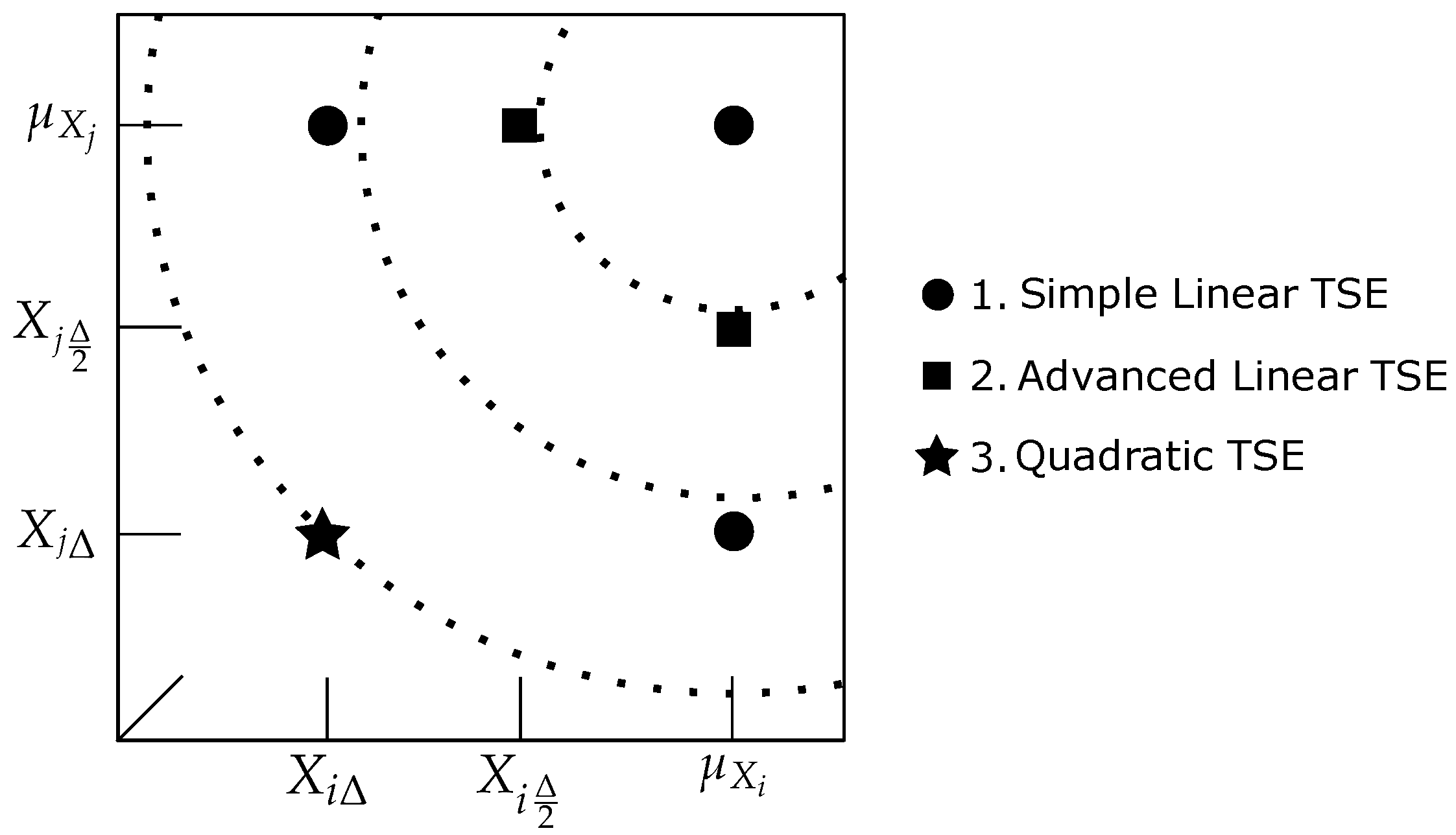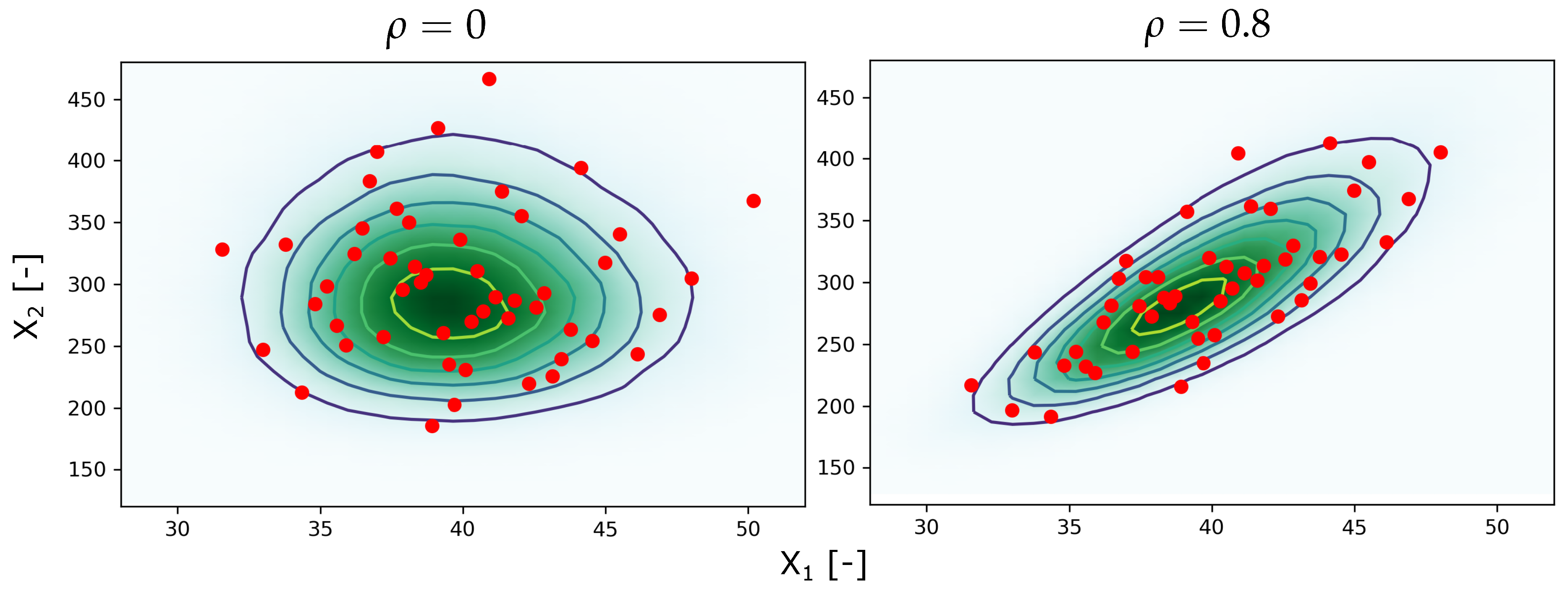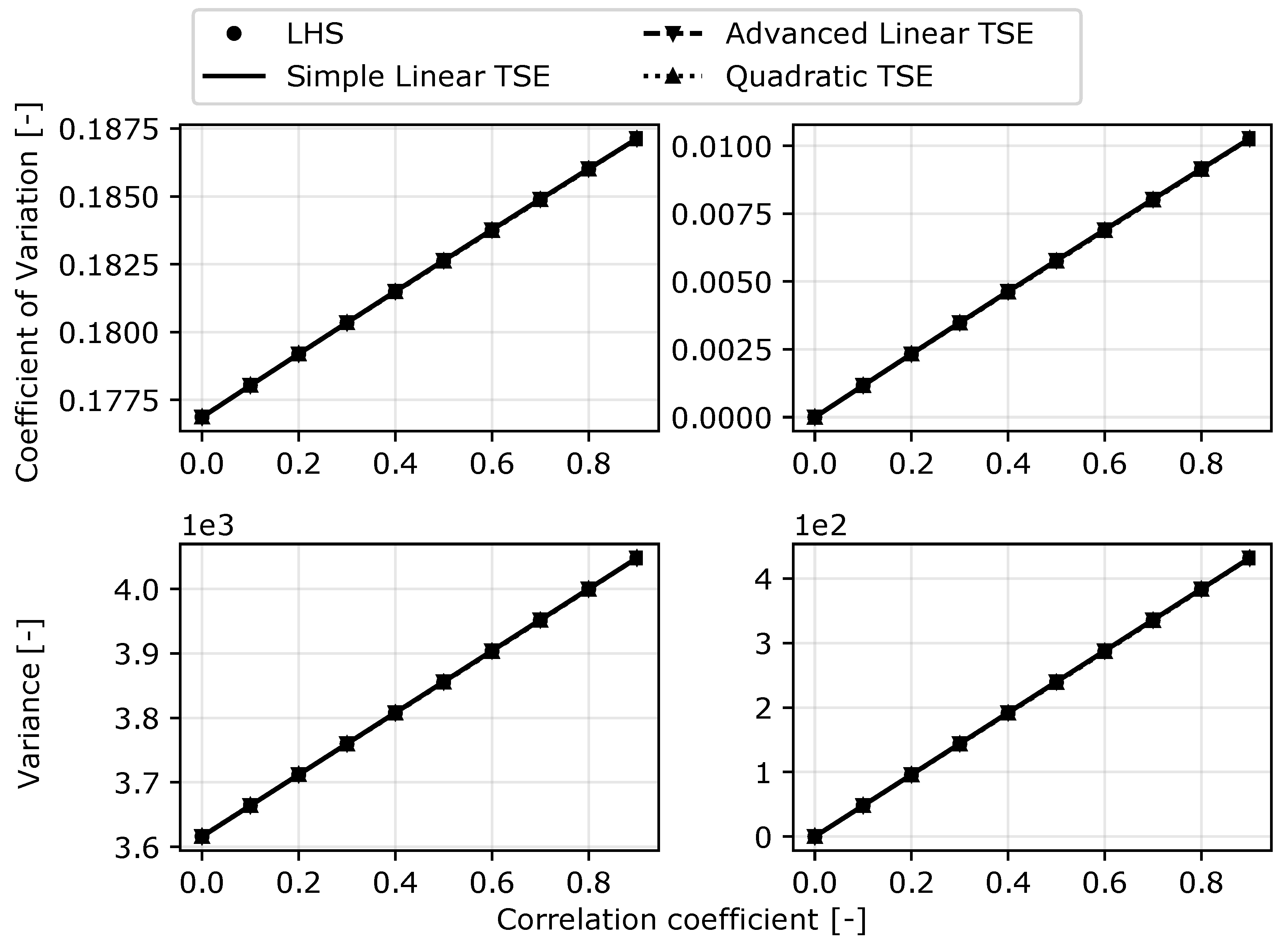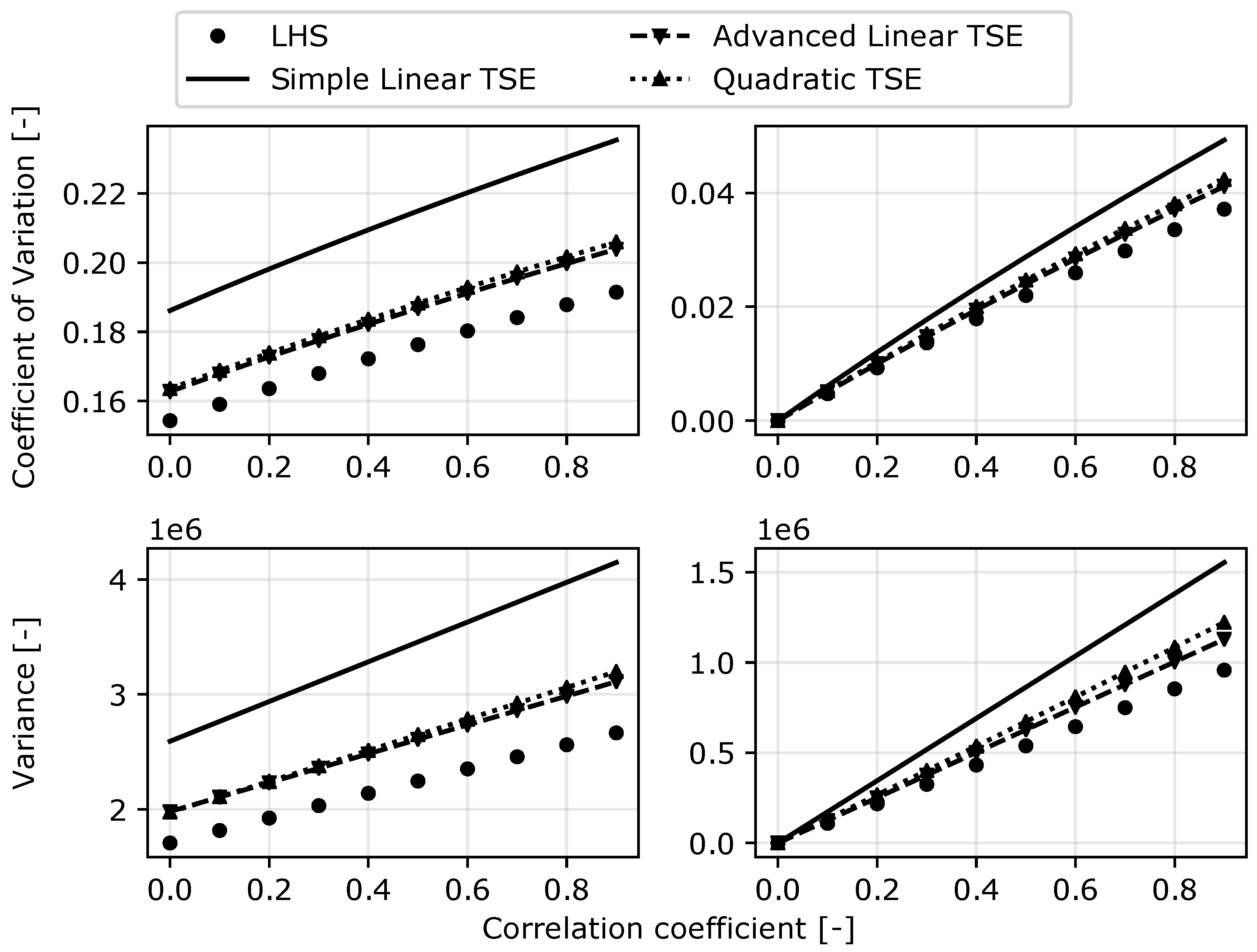On Taylor Series Expansion for Statistical Moments of Functions of Correlated Random Variables †
Abstract
:1. Introduction
2. Taylor Series Expansion
2.1. Linear Terms of Taylor Series Expansion
2.2. Higher-Order Taylor Series Expansion
3. Numerical Computation
3.1. Methodology of ECoV by TSE
3.2. Reference Solution
3.3. Example 1: Simple Linear Model
3.4. Example 2: Linear Model with Interactions
3.5. Example 3: Approximation of Industrial Example
3.6. Example 4: Non-Linear Function
4. Discussion
5. Conclusions
Author Contributions
Funding
Conflicts of Interest
References
- Cornell, C.A. A probability based structural code. J. Am. Concr. Inst. 1969, 66, 974–985. [Google Scholar]
- Comité Européen de Normalisation (CEN). EN 1990: Eurocode: Basis of Structural Design; Comité Européen de Normalisation: Brussels, Belgium, 2002. [Google Scholar]
- Hasofer, A.M.; Lind, N.C. Exact and Invariant Second-moment Code Format. J. Eng. Mech. Div. 1974, 100, 111–121. [Google Scholar]
- Rosenblatt, M. Remarks on a multivariate transformation. Ann. Math. Stat. 1952, 23, 470–472. [Google Scholar] [CrossRef]
- Pimentel, M.; Brühwiler, E.; Figueiras, J. Safety examination of existing concrete structures using the global resistance safety factor concept. Eng. Struct. 2014, 70, 130–143. [Google Scholar] [CrossRef]
- Cervenka, V. Reliability-based non-linear analysis according to fib Model Code 2010. Struct. Concr. 2013, 14, 19–28. [Google Scholar] [CrossRef]
- Val, D.; Bljuger, F.; Yankelevsky, D. Reliability evaluation in nonlinear analysis of reinforced concrete structures. Struct. Saf. 1997, 19, 203–217. [Google Scholar] [CrossRef]
- Cervenka, V. Global Safety Format for Nonlinear Calculation of Reinforced Concrete. Beton Und Stahlbetonbau 2008, 103, 37–42. [Google Scholar] [CrossRef]
- Schlune, H.; Plos, M.; Gylltoft, K. Safety formats for nonlinear analysis tested on concrete beams subjected to shear forces and bending moments. Eng. Struct. 2011, 33, 2350–2356. [Google Scholar] [CrossRef]
- Bertagnoli, G.; Giordano, L.M.; Mancini, G.F. Safety format for the nonlinear analysis of concrete structures. Studi e Ricerche- Politecnico di Milano. Scuola di Specializzazione in Costruzioni in Cemento Armato 2004, 25, 31–56. [Google Scholar]
- McKay, M.D. Latin Hypercube Sampling as a Tool in Uncertainty Analysis of Computer Models. In Proceedings of the 24th Conference on Winter Simulation, Arlington, VA, USA, 13–16 December 1992; pp. 557–564. [Google Scholar]
- Iman, R.L.; Conover, W. Small sample sensitivity analysis techniques for computer models with an application to risk assessment. Commun. Stat. Theory Methods 1980, 9, 1749–1842. [Google Scholar] [CrossRef]
- Sudret, B. Global sensitivity analysis using polynomial chaos expansions. Reliab. Eng. Syst. Saf. 2008, 93, 964–979. [Google Scholar] [CrossRef]
- Blatman, G.; Sudret, B. An adaptive algorithm to build up sparse polynomial chaos expansions for stochastic finite element analysis. Probabilistic Eng. Mech. 2010, 25, 183–197. [Google Scholar] [CrossRef]
- Echard, B.; Gayton, N.; Lemaire, M. AK-MCS: An active learning reliability method combining Kriging and Monte Carlo Simulation. Struct. Saf. 2011, 33, 145–154. [Google Scholar] [CrossRef]
- Lehky, D.; Somodikova, M. Reliability calculation of time-consuming problems using a small-sample artificial neural network-based response surface method. Neural Comput. Appl. 2016, 28, 1249–1263. [Google Scholar] [CrossRef]
- Melchers, R.E.; Beck, A.T. Second-Moment and Transformation Methods. In Structural Reliability Analysis and Prediction; John Wiley & Sons, Ltd.: Hoboken, NJ, USA, 2017; Chapter 4; pp. 95–130. [Google Scholar] [CrossRef]
- Paudel, A.; Thapa, M.; Gupta, S.; Mulani, S.B.; Walters, R.W. Higher-Order Taylor Series Expansion with Efficient Sensitivity Estimation for Uncertainty Analysis. In AIAA Aviation 2020 Forum; American Institute of Aeronautics and Astronautics: Reston, VA, USA, 2020. [Google Scholar]
- Sykora, M.; Cervenka, J.; Cervenka, V.; Mlcoch, J.; Novak, D.; Novak, L. Pilot comparison of safety formats for reliability assessment of RC structures. In Proceedings of the fib Symposium 2019: Concrete—Innovations in Materials, Design and Structures, Kraków, Poland, 27–29 May 2019; pp. 2076–2083. [Google Scholar]
- Novák, L.; Novák, D.; Pukl, R. Probabilistic and semi-probabilistic design of large concrete beams failing in shear. In Advances in Engineering Materials, Structures and Systems: Innovations, Mechanics and Applications; Taylor and Francis Group CRC Press: London, UK, 2019. [Google Scholar]
- Novák, D.; Novák, L.; Slowik, O.; Strauss, A. Prestressed concrete roof girders: Part III—Semi-probabilistic design. In Proceedings of the Sixth International Symposium on Life-Cycle Civil Engineering (IALCCE 2018), Ghent, Belgium, 28–31 October 2018; pp. 510–517. [Google Scholar]
- Lebrun, R.; Dutfoy, A. An innovating analysis of the Nataf transformation from the copula viewpoint. Probabilistic Eng. Mech. 2009, 24, 312–320. [Google Scholar] [CrossRef]
- Lebrun, R.; Dutfoy, A. Do Rosenblatt and Nataf isoprobabilistic transformations really differ? Probabilistic Eng. Mech. 2009, 24, 577–584. [Google Scholar] [CrossRef]
- Comité Européen de Normalisation (CEN). EN 1992: Eurocode 2: Design of Concrete Structures; Comité Européen de Normalisation: Brussels, Belgium, 2004. [Google Scholar]






© 2020 by the authors. Licensee MDPI, Basel, Switzerland. This article is an open access article distributed under the terms and conditions of the Creative Commons Attribution (CC BY) license (http://creativecommons.org/licenses/by/4.0/).
Share and Cite
Novák, L.; Novák, D. On Taylor Series Expansion for Statistical Moments of Functions of Correlated Random Variables. Symmetry 2020, 12, 1379. https://doi.org/10.3390/sym12081379
Novák L, Novák D. On Taylor Series Expansion for Statistical Moments of Functions of Correlated Random Variables. Symmetry. 2020; 12(8):1379. https://doi.org/10.3390/sym12081379
Chicago/Turabian StyleNovák, Lukáš, and Drahomír Novák. 2020. "On Taylor Series Expansion for Statistical Moments of Functions of Correlated Random Variables" Symmetry 12, no. 8: 1379. https://doi.org/10.3390/sym12081379
APA StyleNovák, L., & Novák, D. (2020). On Taylor Series Expansion for Statistical Moments of Functions of Correlated Random Variables. Symmetry, 12(8), 1379. https://doi.org/10.3390/sym12081379




